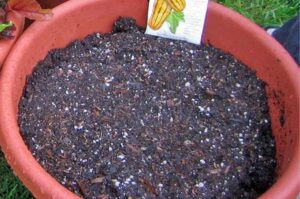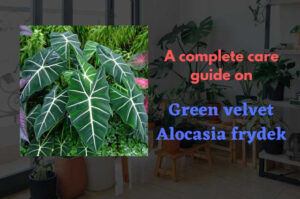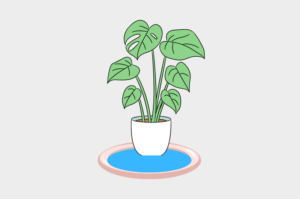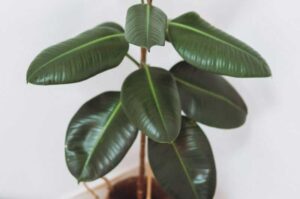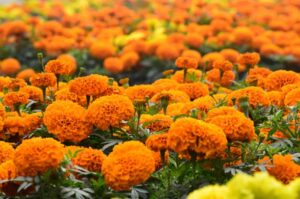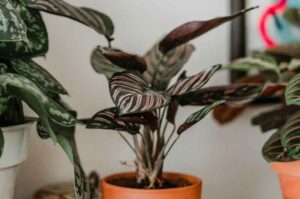Why is my Alocasia Zebrina Drooping? How to prevent it?
Alocasia zebrina is a unique indoor plant having a characteristics appearance of its own. The arrowhead-shaped green leaves along with multi-colored long stems make this plant a beautiful piece of art to be placed as an item of decoration.
However, this beauty will come to you at a cost. You have to take great care of this plant. Then only this plant will grow happily.
This is definitely a difficult plant to take care of. This is a sensitive plant. The adverse conditions will make this plant susceptible to different physiological stress showing different symptoms.
Many people often complain that their Alocasia zebrina plant is drooping, even if they are taking proper care of their plants. This article will cover all the aspects which might result in a droopy Alocasia zebrina plant.

Why is my Alocasia zebrina drooping?
The most common reasons for a droopy Alocasia zebrina plant are overwatering and underwatering. The other reasons for Alocasia zebrina leaves drooping are insufficient lighting, low humidity levels, low temperature, and some unwanted pest incidence. Fixing these problems will surely help your plant to recover.
Here is the list of problems that you should take care of to prevent your Alocasia zebrina plant from drooping.
- Overwatering
- Underwatering
- Insufficient light
- Low humidity
- Temperature stress
- Pest attack
Let us discuss all of the above problems in details.
1.Overwatering
Many people lose their Alocasia zebrina due to overwatering. It is a serious threat to the Zebra plant.
Applying too much water to the Alocasia zebrina is not a good idea. Excess water will fill all the pores inside the potting soil. Hence all the air pockets inside the soil will be removed making an anaerobic condition beneath the soil surface.
This will hamper root respiration. As a result, the root can not perform all its activity. In long run, the root will start rotting in such a waterlogged situation.
Consequences of overwatering
If you have applied excess water accidentally on a few occasions, then there is no issue. However, the same mistake for a long period of time will make the plant susceptible to root rot.
Accidental overwatering will not show any significant symptoms, however, in a few cases, the leaves might turn yellow.
If overwatering continues for a long period of time, then all the leaves will turn yellow. Then gradually they started drooping. Because at this point of time, the roots have started rotting, and therefore they are unable to supply enough water to the plant.
Even if the plant is standing on a moist waterlogged base, there will be a shortage of water because the plant roots are unable to supply the required amount of water to the above-ground plant parts.
If the same situation persist, the plant will ultimately die.
How to check whether an Alocasia zebrina plant is Overwatered or not
You can easily identify the issue visually by observing the plant symptoms and potting soil.
If a plant is showing yellow leaves, immediately check the potting soil. If it is too wet and soggy, you have overwatered the plant.
Also, do the same for a droopy Alocasia zebrina plant. First, check the potting soil. If it is waterlogged, you have un-necessarily applied too much water to the plant.
At the time of repotting check the roots properly. If they are showing any type of rotting symptoms, your plant is at the risk of overwatering and it is high time to correct the issue.
Preventive measures
To prevent your Alocasia zebrina plant from drooping, you have to take the following preventive measures.
- Choose a potting soil that is well-draining. A well-draining potting soil never allows the extra moisture to hold in the soil as a result of which, there won’t be any waterlogging situation. Also, it promotes aeration, which improves root respiration. It will help the plant to establish a healthy root system.
- Make sure that the pot you have selected, should have enough drainage holes so that the extra water can easily escape out of the potting mix. So it is essential to choose a pot having proper drainage holes.
- Choose a proper-sized pot. Never plant your Alocasia zebrina plant in a very big-sized pot. A big pot contains a huge amount of potting mix, which takes a longer time to dry out. Hence it increases the chances of root rot.
- Carefully choose a pot for your Alocasia zebrina plant. The pot should neither be too big nor too small. An extremely small pot can make the plant root-bound.
- Keep your plant in a place, where it can get a good amount of bright indirect sunlight. As a plant of tropical origin, the Alocasia zebrina will love to be in such a place getting a good amount of bright diffused sunlight.
- Also in these areas, the atmospheric temperature is generally high, So the potting soil will dry out easily, reducing the risk of root rotting.
- Check the potting soil regularly. Apply water only when the top two-inch layer of soil is dry. No need to apply too much water, rather it is a good idea to apply a lesser quantity of water in more frequent intervals.
Read our article on How to make a perfect potting soil for Indoor plants? It will help you to make your desired potting soil.
2.Underwatering
Underwatering will definitely make an Alocasia zebrina plant drooping. Lack of water in the crop root zone is a threat to the plant. As a response to which the plant starts to lose its luster and start drooping.
On adding water again, the plant will resume its growth again. But if a dry condition continues for a longer duration, then it is a matter of concern.
A prolonged period of dry condition makes this plant droopy, and if this condition still persists, the plant will ultimately die.
Preventive measures
To prevent the Alocasia zebrina plant from drooping due to underwatering, the only thing you can do is apply timely irrigation. Check the soil regularly. If the top two-inch layer of soil is feeling dry, then go for light irrigation.
Never flood the potting soil with too much water. The thumb rule is to apply less amount of water, but more frequently.
You can also keep the environment humid, this will also help the plant to stay moist and hydrated.
3.Low humidity
All tropical plants need a humid environment for their proper growth and development. So does the Alocasia zebrina plant do.
This plant is originated on the floor of the tropical rainforest. This place doesn’t get direct and bright sunlight, rather it is under the shade of big trees. This place has generally very high humidity.
Therefore, to mimic their homely environment it is a good decision to keep this plant in a humid environment.
Low humidity levels hamper the growth and make this plant look pale and droopy. A moist and humid environment also promotes the soil water to hold in the soil for a long duration. As it evaporates less quickly chances of water deficiency are less.
A few methods to keep the environment humid
- Pebble tray– A pebble tray is an effective method to keep the environment moist and humid. It is also easy to use this method.
- Misting- Misting is also an important solution to a dry environment. Misting regularly will make the atmosphere humid and maintain a suitable microclimate for tropical plants like the Alocasia.
- Use a humidifier– A good humidifier can automatically adjust the desired humidity levels at your home and provide the desired environment for your plant.
- Group your plants– Grouping of plants is also an effective solution to make the environment humid. By their mutual effect of transpiration, the nearby area will remain humid.
These are a few methods using which you can keep humidity levels up.
You will also love to read the Care guide for- Alocasia baginda silver dragon.
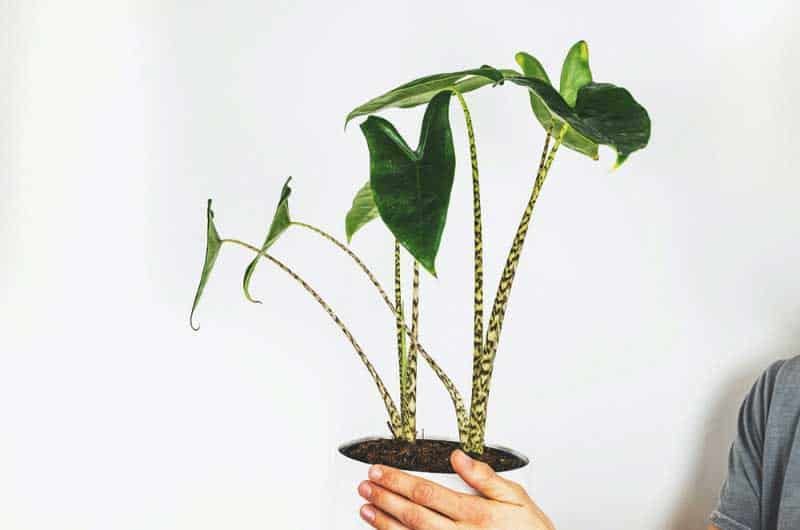
4.Low light
Like all other Alocasias, the Alocasia zebrina also loves to stay in a place where it can get bright indirect sunlight. But for a plant getting too much low light, it will be difficult to carry out photosynthesis.
Therefore, the plant will droop and fade its color.
A perfect place for Alocasia zebrina will get a good amount of bright indirect sunlight. A place near the east or north-facing window is ideal for the plant.
Never allow this plant also to stand in too much direct sunlight for a long time. It will burn the delicate leaves of this plant.
Carefully take care of lighting part of things.
5.Temperature stress
Alocasia zebrina plant loves to grow in a temperature range of 16 to 25 degrees Celcius. Extremely low temperatures make the plant susceptible to chilling injury.
Temperature stress also can make this plant drooping. You have to pay attention in the winter days.
Alocasias are more susceptible to cold temperatures.
6.Pest attack
Generally, Alocasia zebrina is not susceptible to any pest. But a few sap-sucking pests like the spider mites, mealybugs, thrips, aphids may put this plant into trouble.
These pesky pests suck the plant sap and make the plant look droopy. They might also cause some severe disease transmission.
Preventive measures
To prevent your Alocasia from pest attack you can take the following preventive measures
- Daily inspection of plants will give you an idea of pest infestation.
- If any pest found, use natural insecticides like neem oil.
- Wiping the plants with alcohol-soaked cotton pieces will keep the plants pest-free.
Sap sucking pests are important to control, otherwise, they will make your plant droopy.
Final thoughts
The major issue for which your Alocasia zebrina plant is drooping is related to watering, it may be overwatering or underwatering. Other discussed issues are the subsidiary sections which make the problem more severe.
If your Alocasia zebrina plant has just started drooping the first thing you have to do is to change your watering habits. First, you have to analyze whether you are applying too much or too little water to the plant.
Then you have to look at other aspects of the problem like the selection of wrong potting soil, wrong sized pot, a wrongly placed plant, and so on. Once you have got the mistake, then go and correct it, and your plant will again revive.

